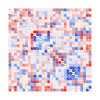Dissection of genetic and environmental factors involved in tomato organoleptic quality
- PMID: 21453463
- PMCID: PMC3080294
- DOI: 10.1186/1471-2229-11-58
Dissection of genetic and environmental factors involved in tomato organoleptic quality
Abstract
Background: One of the main tomato breeding objectives is to improve fruit organoleptic quality. However, this task is made somewhat challenging by the complex nature of sensory traits and the lack of efficient selection criteria. Sensory quality depends on numerous factors, including fruit colour, texture, aroma, and composition in primary and secondary metabolites. It is also influenced by genotypic differences, the nutritional regime of plants, stage of ripening at harvest and environmental conditions. In this study, agronomic, biochemical and sensory characterization was performed on six Italian heirlooms grown in different environmental conditions.
Result: We identified a number of links among traits contributing to fruit organoleptic quality and to the perception of sensory attributes. PCA analysis was used to highlight some biochemical, sensory and agronomic discriminating traits: this statistical test allowed us to identify which sensory attributes are more closely linked to environmental conditions and those, instead, linked to the genetic constitution of tomato. Sweetness, sourness, saltiness and tomato flavour are not only grouped in the same PCA factor, but also result in a clear discrimination of tomato ecotypes in the three different fields. The three different traditional varieties cluster on the basis of attributes like juiciness, granulosity, hardness and equatorial diameter, and are therefore more closely related to the genetic background of the cultivar.
Conclusion: This finding suggests that a different method should be undertaken to improve sensory traits related to taste perception and texture. Our results might be used to ascertain in what direction to steer breeding in order to improve the flavour characteristics of tomato ecotypes.
Figures




Similar articles
-
QTL analysis of fruit quality in fresh market tomato: a few chromosome regions control the variation of sensory and instrumental traits.J Exp Bot. 2002 Oct;53(377):2089-98. doi: 10.1093/jxb/erf058. J Exp Bot. 2002. PMID: 12324532
-
Use of network analysis to capture key traits affecting tomato organoleptic quality.J Exp Bot. 2009;60(12):3379-86. doi: 10.1093/jxb/erp177. Epub 2009 Jun 10. J Exp Bot. 2009. PMID: 19516072 Free PMC article.
-
Contrasting metabolic profiles of tasty Andean varieties of tomato fruit in comparison with commercial ones.J Sci Food Agric. 2018 Aug;98(11):4128-4134. doi: 10.1002/jsfa.8930. Epub 2018 Mar 30. J Sci Food Agric. 2018. PMID: 29393974
-
The Genetic Basis of Tomato Aroma.Genes (Basel). 2021 Feb 4;12(2):226. doi: 10.3390/genes12020226. Genes (Basel). 2021. PMID: 33557308 Free PMC article. Review.
-
The expanded tomato fruit volatile landscape.J Exp Bot. 2014 Aug;65(16):4613-23. doi: 10.1093/jxb/eru128. Epub 2014 Apr 1. J Exp Bot. 2014. PMID: 24692651 Review.
Cited by
-
Untargeted NMR Study of Metabolic Changes in Processing Tomato Treated with Trichoderma atroviride Under Open-Field Conditions and Exposed to Heatwave Temperatures.Molecules. 2024 Dec 29;30(1):97. doi: 10.3390/molecules30010097. Molecules. 2024. PMID: 39795154 Free PMC article.
-
Improving the Commercial Value of the 'Calçot' (Allium cepa L.) Landrace: Influence of Genetic and Environmental Factors in Chemical Composition and Sensory Attributes.Front Plant Sci. 2018 Oct 4;9:1465. doi: 10.3389/fpls.2018.01465. eCollection 2018. Front Plant Sci. 2018. PMID: 30337937 Free PMC article.
-
Comparative Chemical Compositions of Fresh and Stored Vesuvian PDO "Pomodorino Del Piennolo" Tomato and the Ciliegino Variety.Molecules. 2018 Nov 3;23(11):2871. doi: 10.3390/molecules23112871. Molecules. 2018. PMID: 30400320 Free PMC article.
-
Effects of Genotype, Storage Temperature and Time on Quality and Compositional Traits of Cherry Tomato.Foods. 2020 Nov 25;9(12):1729. doi: 10.3390/foods9121729. Foods. 2020. PMID: 33255529 Free PMC article.
-
Metabolite Profiling of Italian Tomato Landraces with Different Fruit Types.Front Plant Sci. 2016 May 19;7:664. doi: 10.3389/fpls.2016.00664. eCollection 2016. Front Plant Sci. 2016. PMID: 27242865 Free PMC article.
References
-
- Maul F, Sargent SA, Sims CA, Baldwin EA, Balaban MO, Huber DJ. Tomato flavor and aroma quality as affected by storage temperature. J Food Sci. 2000;65:1228–1237. doi: 10.1111/j.1365-2621.2000.tb10270.x. - DOI
-
- Baldwin EA, Nisperos-Carriedo MO, Baker R, Scott JW. Qualitative analysis of flavor parameters in six Florida tomato cultivars. J Agric Food Chem. 1991;39:1135–1140. doi: 10.1021/jf00006a029. - DOI
-
- Baldwin EA, Nisperos-Carriedo MO, Moshonas MG. Quantitative analysis of flavor and other volatiles and for certain constituents of two tomato cultivars during ripening. J Am Soc Hortic Sci. 1991;116:265–269.
-
- Buttery RG. In: Amer Chem Soc. Acree TE, Teranishi R, editor. Washington, DC; 1993. Quantitative and sensory aspects of flavor of tomato and other vegetables and fruits; pp. 259–286. Flavor science: sensible principles and techniques.
Publication types
MeSH terms
Substances
LinkOut - more resources
Full Text Sources

